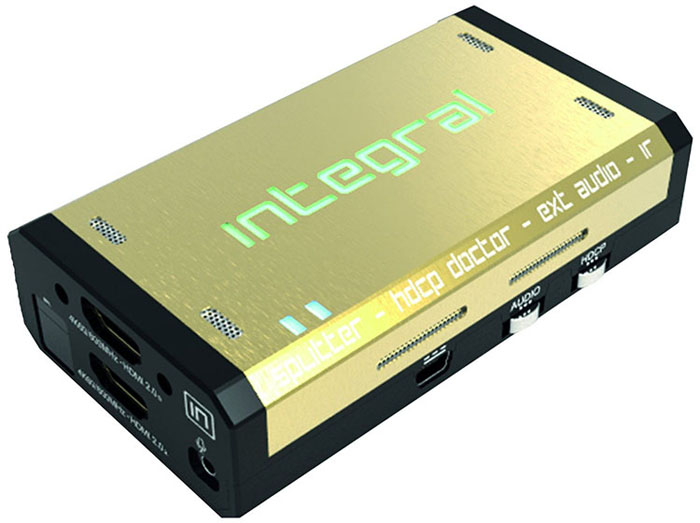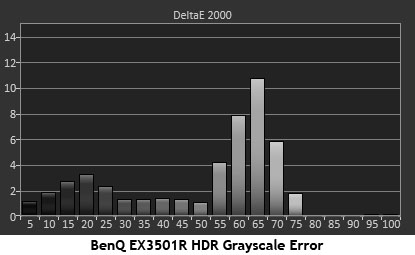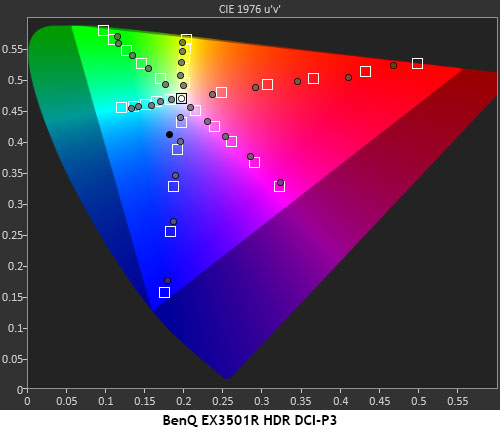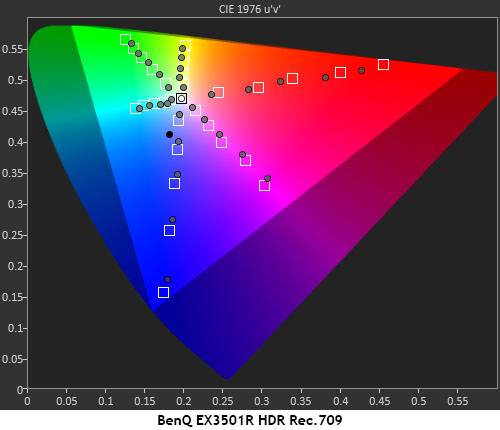BenQ EX3501R 35" VA Curved FreeSync HDR Gaming Monitor Review: Good Gaming, Great Looks
Why you can trust Tom's Hardware
HDR Grayscale, EOTF and Color
To run HDR benchmarks, we add an HD Fury Integral to the signal chain to simulate HDR10 content from our Accupel DVG-5000 pattern generator. This enables us to measure the EX3501R’s grayscale in 5% increments, tracking of Electro-Optical Transfer Function (EOTF), an electronic value in content that specifies brightness displayed on the monitor, and color gamut capabilities within a Rec.2020 container.

Grayscale Tracking & EOTF
The EX3501R has no adjustments available in HDR mode.



The EX3501R’s HDR grayscale tracking is among the best we’ve seen from any display. This is excellent performance, especially considering this is not a professional monitor with a factory-certified calibration.
The errors at 60% and 65% are caused by incorrect luminance levels. What does that mean in real-world context? Almost nothing. You might see occasional detail clipping in the upper mid-tones, but we never experienced this during our hands-on tests.
The deepest blacks are a little too bright as well. Luminance rises too quickly until 30%, where it gets back on track. These are minor points in the grand scheme of things but worth reporting.
Color Gamuts Within Rec.2020



The EX3501R is essentially an sRGB monitor, so to simulate the extended primaries of DCI-P3 and Rec.2020, it alters their hues to push them closer to the gamut triangle’s edge. You’ll see a little deeper red, but the saturation level is the same.
While under-saturation is expected in the Rec.2020 and DCI charts, we were surprised to see it in the Rec.709 graph. Red is the biggest culprit and undercuts its targets across the board. DCI material will look okay here, but if an Ultra HD disc is mastered in Rec.709, it might be a tad less colorful.
The takeaway from our HDR tests is that while the EX3501R does some things well, it has room for improvement in others.
Ultra HD Blu-rays
The EX3501R is one of the few computer monitors that processes 24p film-based material correctly. Most screens use a cadence to adapt this content to a 60Hz refresh rate, but BenQ has thoughtfully included proper support for this common framerate.
Unfortunately, we discovered a flaw in its aspect ratio handling. Since the native shape is 21:9, or 2.33:1 in movie terms, a CinemaScope movie should fill the screen. But when we watched Creed the image still displayed black bars on top and bottom. Our player does not have a vertical stretch option, and the EX3501R doesn’t either. You can select Aspect in the OSD to remove the horizontal stretch, but then there are bars on all sides.
Aspect issues aside, the image looks fantastic. 3840x2160 resolution is happily accepted and cleanly down-converted. Color is exemplary, and contrast looks fantastic in both HDR and SDR modes. The difference is small but noticeable - most content has a little more pop in HDR. For example, The Martian, with its vivid orange landscapes was a real treat to watch. Detail is razor-sharp, and at desktop viewing distances you’ll never know you’re not watching native UHD.
We’d love it if BenQ included a vertical stretch mode, but otherwise, the EX3501R is a great movie machine.
MORE: Best Gaming Monitors
MORE: How We Test Monitors
MORE: All Monitor Content
Current page: HDR Grayscale, EOTF and Color
Prev Page Grayscale, Gamma and Color Next Page Viewing Angles, Uniformity, Response and FreeSyncStay On the Cutting Edge: Get the Tom's Hardware Newsletter
Get Tom's Hardware's best news and in-depth reviews, straight to your inbox.

Christian Eberle is a Contributing Editor for Tom's Hardware US. He's a veteran reviewer of A/V equipment, specializing in monitors. Christian began his obsession with tech when he built his first PC in 1991, a 286 running DOS 3.0 at a blazing 12MHz. In 2006, he undertook training from the Imaging Science Foundation in video calibration and testing and thus started a passion for precise imaging that persists to this day. He is also a professional musician with a degree from the New England Conservatory as a classical bassoonist which he used to good effect as a performer with the West Point Army Band from 1987 to 2013. He enjoys watching movies and listening to high-end audio in his custom-built home theater and can be seen riding trails near his home on a race-ready ICE VTX recumbent trike. Christian enjoys the endless summer in Florida where he lives with his wife and Chihuahua and plays with orchestras around the state.
-
Diji1 >Right now, there are no games that can take advantage of HDRReply
Uh ... Assassin's Creed: Origins, Final Fantasy VI? -
DerekA_C mass effect andromeda I'm more concerned with that 4ms at 100hz YUCK already bought ASUS version and it was TRASH returned it motion blur and input lag VA is not where it needs to be yet ISP is still better.Reply -
jcroe72 why are screens being made with internal bezel a portion of the edges being useless its very ugly and misleadingReply -
Dantte Reply21097935 said:mass effect andromeda I'm more concerned with that 4ms at 100hz YUCK already bought ASUS version and it was TRASH returned it motion blur and input lag VA is not where it needs to be yet ISP is still better.
I think you're confusing response time with input lag:
Response Time is a measure of how fast a pixel can turn on/off (yes I'm simplifying this...) and is what affects "motion blur". VAs are generally faster and better then IPS here and there are ways to fix a monitor with a slow response such as using ULMB.
Input Lag is the time it takes for a signal sent out by the source to be displayed on the screen, this has no effect on motion blur and IPS are generally faster than VA here. Example, click you mouse button and (40ms) later that action takes place on the screen, this is input lag.
If you're truely concerned about either of the above items, get a TN panel as it smokes both IPS and VA in both fields, but you will lose a lot of color, contrast, and viewing angle with a TN. I use to do competitive game and my main gaming monitor is still a TN; anytime I'm on a VA or IPS something just feels off and i suspect its the display speed. I didnt give up my CRT (NEC FP2141SB) as my main gaming monitor until 2012 if this says anything about it... -
Colin_10 Been waiting for a monitor like this, after experiencing 144hz, going back to a 60hz monitor just for the larger size and curvature wasn't acceptable. A Curved/Freesync/VA/100Hz is in the sweet spot for me.Reply